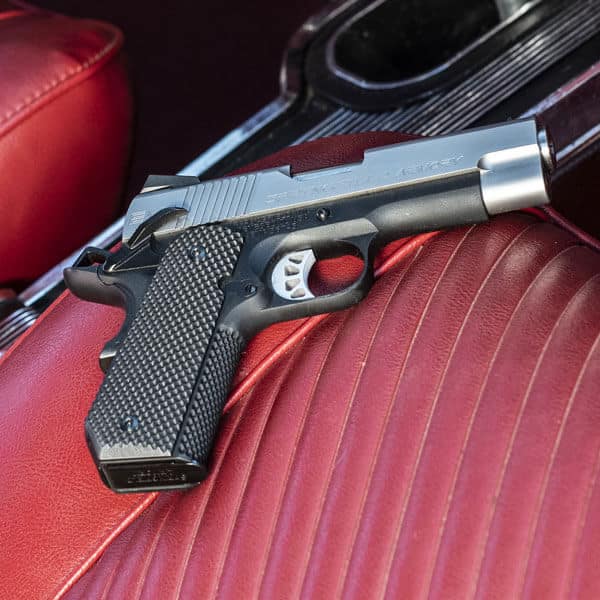Is Slide-to-Frame Fit Important for Accuracy?
June 1st, 2019
6 minute read
Many factors contribute to accuracy, such as ammunition, barrel fit, and the tolerance of how precisely the critical parts fit together. With many semi-automatic pistols, the barrel has to be locked in the same position in the slide for every shot, and the slide has to be aligned in the same position with the frame every time. Any variation in alignment of these parts means the barrel will be pointed at a different spot from one shot to another.
Jerry Kuhnhausen (The Colt .45 Automatic: A Shop Manual, VSP Publishers, McCall, Idaho, 1990) says that slide to frame fit accounts for about 15 percent of accuracy when compared to all the other mechanical variables, such as barrel and bushing fit, headspace, etc.
I have a Para Ordnance high-capacity frame that I use with several slides of various calibers. As one might expect from a multi-caliber system, slide-to-frame fit varies, depending on which slide is used. With one 9mm Luger setup, the Kart barrel is closely fit to the slide and frame with no movement of the barrel when the slide is forward in full battery.
However, there is visible slop in the slide-to-frame fit. How loose is the slide? If I push left or right on the front of the slide, I can both see and feel it move. Yup, it’s a little loose.
Even with this visibly loose slide-to-frame fit, the gun can produce some nice groups at 25 yards with ammunition it likes. There are a dozen loads that will put 20 rounds in less than two inches at 25 yards. Two-inch groups won’t win any bullseye matches, but it’s more than sufficient for most shooting tasks.
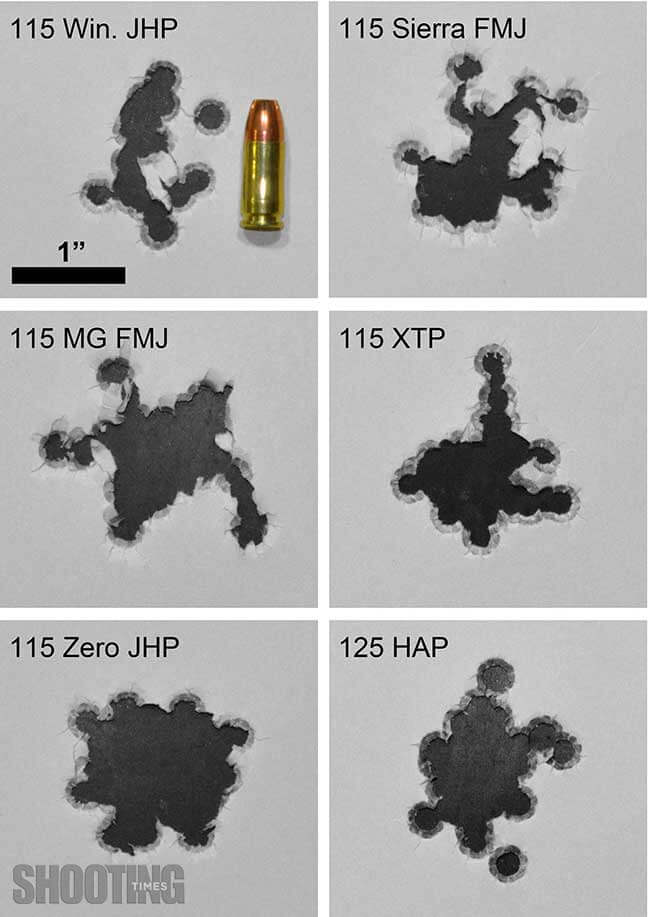
Several examples of 20-shot groups powered by Vihtavuori N350 are shown in Figure 1. All groups are less than two inches. The gun was fired while mounted in a Ransom Rest at 25 yards.
A Ransom Rest holds the gun by the frame (Figure 2). When properly secured, the frame does not move at all, short of a direct hit from an atomic bomb. Obviously, the slide is free to move as it does so when fired, and it is also free to wiggle around depending on how tightly it fits the frame.
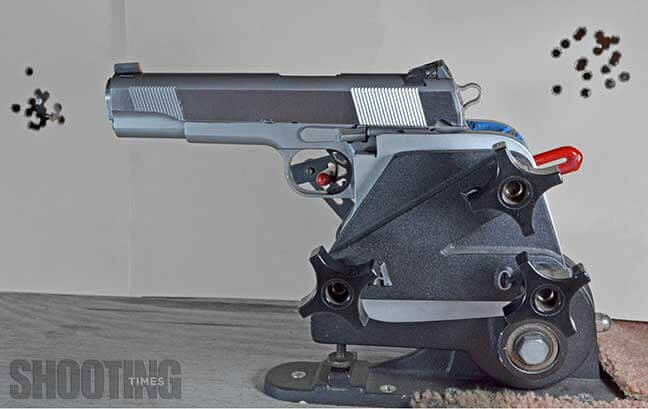
When this gun is placed in the Ransom Rest, I can wiggle the slide a little from side-to-side. It has little, if any, vertical play. I wondered how much the loose slide-to-frame fit affected my groups.
Based on the movement I could see and feel, I imagined that it could shoot separate groups on the same target if I simply pushed the slide to the right for 10 shots, then to the left for 10 shots (Figure 3). Naturally, I would need ammunition that would normally produce a tight group in order to have non-overlapping groups. I had plenty of loads that fit that description. So I tried it. And guess what? I was right.
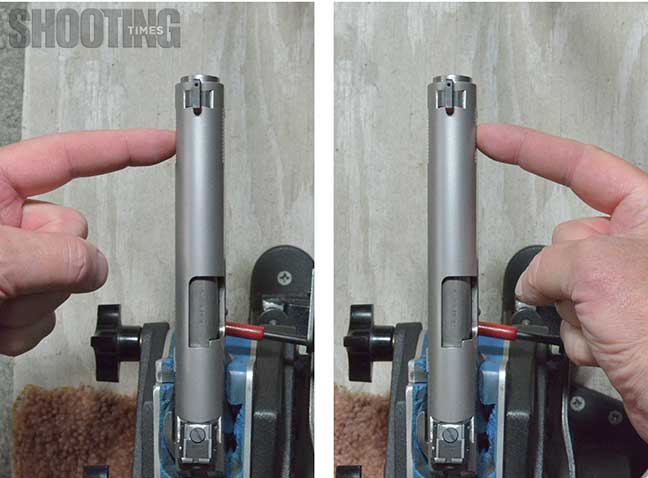
Figure 4 shows two separate targets, both shot with the same ammunition (115 grain Winchester JHP driven with N350). Target No. 1 is a 20-shot group. The maximum spread is 1.37 inches, which results from the vertical distribution of hits. The maximum horizontal spread is 1.02 inches.
Target No. 2 shows two groups of 10 shots each on one piece of paper. For the group on the left, I pushed the front of the slide to the left and down. For the group on the right, I pushed the front of the slide right and up. Some methodological details are necessary: I gently pushed the slide in the direction as noted. It moved freely. I didn’t hold the slide there when the gun was fired (that could get painful). Once the slide was moved to the side, it stayed there.
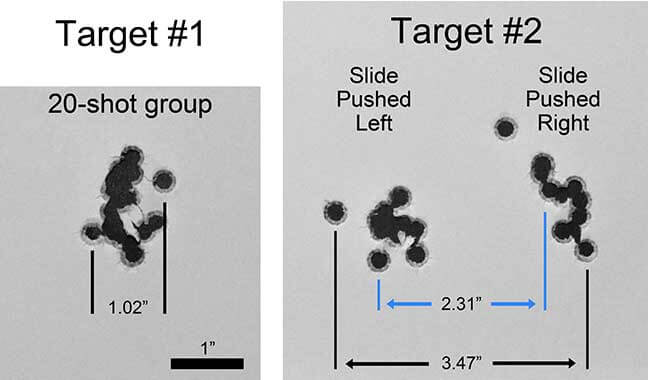
The left 10-shot group’s maximum spread measures 1.27 inches, and the right 10-shot group’s maximum spread measures 2.03 inches because of that pesky high flier. The horizontal spread of the left group is 1.13 inches, and the horizontal spread of the right group is 1.10 inches.
This is where it starts to get interesting. The distance between the center of the left group and the center of the right group is 2.31 inches (blue lines). Note that this is wider than the horizontal spread of the 20-shot Target No. 1. In fact, that 20-shot group would easily fit in-between the left group and right group.
Here’s another measurement. The center-to-center distance from the farthest hit on the left group to the farthest hit on the right group is 3.47 inches (black lines). If this is the maximum widest spread that this sloppy slide-to-frame fit will produce with this ammunition, why aren’t all the groups I shoot with this ammunition that big?
It’s because when the slide returns to battery after firing, it returns to more-or-less a “centered” position, that is, not very far canted to the left or right. This is supported by the fact that virtually every time I pushed the front of the slide to one side, it moved. In order for the slide to have moved when I pushed it, it had to not already be all the way to that side.
I fired 170 rounds during that test session by pushing the front of the slide to the side. In a few instances when I pushed the slide, it did not move – the front of the slide was already all the way to the left or right after cycling. But this was rare. This suggests that some of the occasional fliers I see might be due to the slide not being centrally positioned like it normally is after cycling.
At least, that is possible with the fliers is see with accurate ammunition. It’s not unusual to see several fliers with inaccurate ammunition. And fliers do happen whatever their cause; presumably the high flier in the right 10-shot group of Target No. 2 falls into the “not readily explained” category of fliers.
I’ve replicated the two-group effect with different bullets. Another example is shown in Figure 5 with Hornady 125 grain HAP bullets powered by Alliant Power Pistol. The horizontal spread of the 20-shot group is 2.00 inches (Target #3). The distance between the center of the left group and center of the right group is 3.33 inches (blue lines).
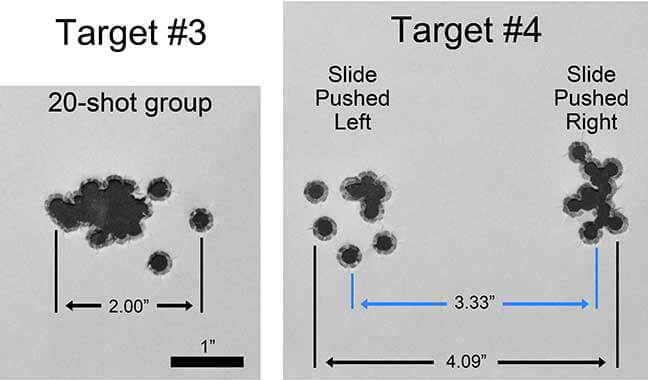
The center-to-center distance from the farthest hit on the left group to the farthest hit on the right group is 4.09 inches (black lines). Here again, the horizontal spread of the 20-shot group when I don’t touch the slide is a fraction of the potential horizontal spread of the two 10-shot groups in Target No. 4.
I used the left group/right group center-to-center numbers from the two different bullets to estimate the amount of side-to-side barrel movement due to the loose slide-to-frame fit. The average is 2.82 inches, and doing a little math I came up with a value of 0.016 inches of left-right front barrel movement when the front of the slide is manually moved left and right.
What does the two-group phenomenon mean? Does it mean that slide-to-frame fit is not important? No. Slide to frame fit is important, but as Jerry Kuhnhausen notes, it is but one element of several that contributes to accuracy. Barrel fit is the most important. As this example demonstrates, if the barrel is pointed at a different spot, that’s where the bullet goes.
This small experiment demonstrates that a little slop in the slide-to-frame fit might not necessarily result in poor accuracy. At least for this pistol, the slide tends to return to about the same position when fired. This results in better accuracy than what it would produce if the slide returned to a random position within the range of available movement.
If your slide has a little slop in its fit with the frame, take heart. It might shoot fine in spite of it. If your groups are large, make sure you’ve eliminated other potential sources of error, such as ammunition (which has a huge effect on accuracy) and barrel/bushing fit. As these results show, a little slop in the slide-to frame fit might not be as bad as it looks.
At the same time, eliminating the slop is a good idea if your goal is the best possible accuracy. Accuracy performance can be improved when the slide-to-frame fit is tightened by preventing the slide position to wander. A more precisely fit slide will shrink group size and prevent fliers that result from errant slide position.
Editor’s Note: This article was written by Brad Miller, Ph.D. and shared with us by Shooting Times.
Join the Discussion
Continue Reading
Did you enjoy this article?

 26
26





